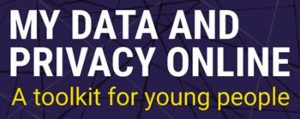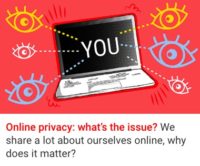“What do children know, and want to know, about where their data goes?” is the all-important question that leads the Children’s Data & Privacy Online project’s blog post about its just-released report. I say “all-important” because it’s a fundamental right of children to form and express their views on matters that affect them (see Article 12 of the UN Convention of the Rights of the Child).
 Here are key takeaways about kids’ data awareness and expectations in a short, readable blog post by Gianfranco Polizzi and Sonia Livingstone at the London School of Economics (Livingstone, Mariya Stoilova and Rishita Nandagiri are the authors of the full report):
Here are key takeaways about kids’ data awareness and expectations in a short, readable blog post by Gianfranco Polizzi and Sonia Livingstone at the London School of Economics (Livingstone, Mariya Stoilova and Rishita Nandagiri are the authors of the full report):
- Kids see what they post and share online in personal and social, not transactional, terms. To them, it’s not “data,” as it is to the apps and services they use to socialize, play, learn, influence, help and seek help. This makes perfect developmental sense but has not been considered nearly enough by the businesses, institutions and governments that use, process, store and otherwise have control of their “data.” So of course…
- Kids don’t know if, how or why their data is used, stored and sold. So, for example, they don’t know what is “known” about them by apps and services they use and how that knowledge turns into ads they see or who/what turns up in their “feeds.” Because all this is new and the public’s awareness of it even newer, few parents and educators understand these things either, so we haven’t been able to educate them.
 Kids want to know what happens to their data (from what they post and share) because, “when they realise how businesses monetise (and can misuse) their data, they feel outraged and powerless,” the project reports. Completely understandable, right? I’m sure the young participants in these focus groups weren’t asked leading questions because the groups were conducted by scholars, so here’s what else kids said they want: that apps and services 1) make their terms and conditions comprehensible to kids, i.e. kid-friendly, 2) only ask kids for information that’s relevant (I think that means data that’s necessary to operate and improve the service, a principle behind the US’s children’s privacy law, COPPA), 3) make kids’ accounts private by default, 4) make it so kids can delete their content, or data, permanently and 5) not share kids’ data “beyond the app or service” where kids post it. [Some of this would be hard without age-verification, which problematically would require the collection of even more data from kids, and that goes against the data security principle of “data minimization.”]
Kids want to know what happens to their data (from what they post and share) because, “when they realise how businesses monetise (and can misuse) their data, they feel outraged and powerless,” the project reports. Completely understandable, right? I’m sure the young participants in these focus groups weren’t asked leading questions because the groups were conducted by scholars, so here’s what else kids said they want: that apps and services 1) make their terms and conditions comprehensible to kids, i.e. kid-friendly, 2) only ask kids for information that’s relevant (I think that means data that’s necessary to operate and improve the service, a principle behind the US’s children’s privacy law, COPPA), 3) make kids’ accounts private by default, 4) make it so kids can delete their content, or data, permanently and 5) not share kids’ data “beyond the app or service” where kids post it. [Some of this would be hard without age-verification, which problematically would require the collection of even more data from kids, and that goes against the data security principle of “data minimization.”]
These are only some of the findings from focus groups with 150 UK 11-to-16-year-olds; other eminently understandable wishes on kids’ data privacy wish list are on this page from the report.
I feel the blog post at the very least is a digital age must-read for parents, educators and policymakers. Importantly, it asks and answers the question “What should be done?” for tech companies, governments, schools, parents and “civil society, the media industry and academics.” We all have a role now in educating ourselves, each other and our children.

But the project goes beyond making recommendations to providing the tools: a “Privacy Toolkit,” in fact, co-created with and designed specifically for secondary, or high school, students. It has 9 modules: “What’s the Issue?”, “Who has my data?”, “Who’s tracking me?”, “What are my rights?”, “What can go wrong?”, “What do children ask for?” (covered above), “How to protect my privacy?”, “Where to get help?” and “Watch & play” (short videos and games).
This is essential knowledge in the digital age. Yet most of us parents and educators didn’t need it when we were growing up. So it’s not yet intuitive for parents to pass it down to their children or schools to include it in the curriculum. That makes teaching these data basics – in homes, schools, after school programs, wherever – even more of an imperative and this “toolkit” truly valuable. What only increases its value is that it incorporated the views and participation of the age group for which it’s designed. It was developed under a Creative Commons copyright so likely can be translated and adapted for students in any society with the creators’ permission. I hope you’ll join me in spreading the word.

Leave a Reply